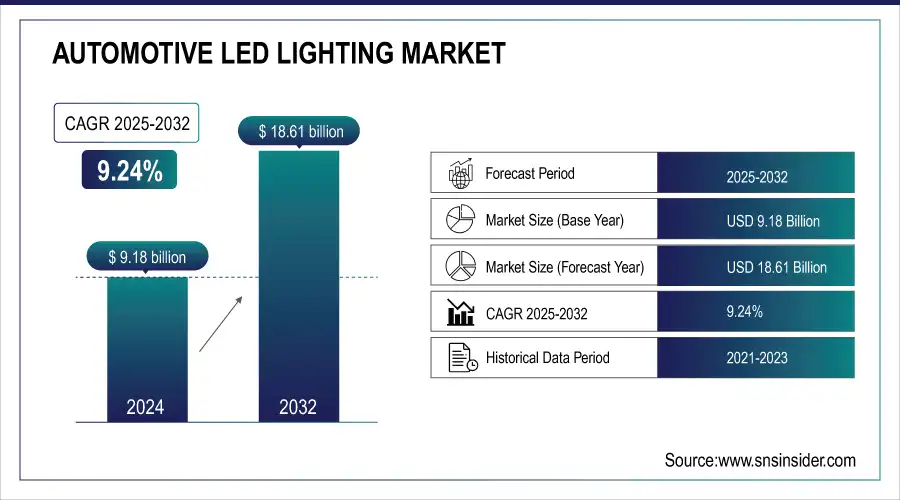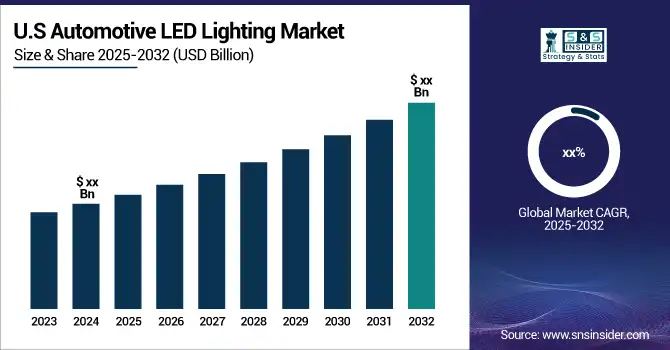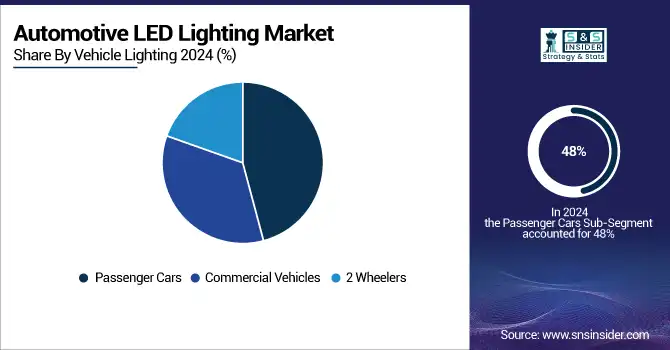Automotive LED Lighting Market Size & Analysis:
The Automotive LED Lighting Market was valued at USD 9.18 billion in 2024 and is expected to reach USD 18.61 billion by 2032, growing at a CAGR of 9.24% from 2025-2032.

To get more information on Automotive LED Lighting Market - Request Free Sample Report
The Automotive LED Lighting Market is experiencing strong growth, driven by energy efficiency, longer lifespan, and versatile color visibility compared to halogen and xenon lights. Technological advancements, including dynamic, matrix, and laser lighting, enhance vehicle aesthetics, functionality, and driver-assist features. LED adoption is rising in electric and luxury vehicles due to lower power consumption, supporting battery life and vehicle range. Government regulations mandating energy-efficient and safe lighting, along with increasing demand for electric and premium vehicles, further fuel growth. Falling LED prices, improved thermal management, and expanding interior and exterior applications make these solutions more accessible. While initial costs and integration complexity remain challenges, ongoing R&D is expected to improve efficiency, reduce costs, and drive broader adoption globally.

Market Size and Forecast
-
Market Size in 2024: USD 9.18 Billion
-
Market Size by 2032: USD 18.61 Billion
-
CAGR: 9.24% from 2025 to 2032
-
Base Year: 2024
-
Forecast Period: 2025–2032
-
Historical Data: 2021–2023
Automotive LED Lighting Market Trends
-
Rising demand for energy-efficient, durable, and high-performance lighting is driving the automotive LED lighting market.
-
Increasing adoption in headlamps, tail lamps, interior, and signal lighting is boosting market growth.
-
Integration with smart vehicle systems, ADAS, and autonomous driving technologies is enhancing safety and functionality.
-
Expansion of electric and premium vehicle segments is fueling LED lighting adoption.
-
Advancements in miniaturization, brightness, and color control are improving design flexibility.
-
Focus on reducing vehicle energy consumption and carbon emissions is shaping market trends.
-
Collaborations between automotive OEMs, LED manufacturers, and technology providers are accelerating innovation and deployment.
Automotive LED Lighting Market Growth Drivers:
-
Automakers use LED lighting for dynamic designs, ambient interior lighting, and brand differentiation.
LED lighting technology has increasingly been helping automakers establish dynamic designs, luxurious aesthetic ambiance, and brand distinction in the competitive automotive market. LED lighting permits more freedom of design, allowing manufacturers to create a more modern and futuristic look for vehicles. Signature LED daytime running lights, fleeting and sequential turn signals, and laser-based headlights can all help make a vehicle stand out while also improving visibility and therefore safety on the road. Such lighting features are frequently incorporated into brand identity, allowing automakers to build a "signature" look to help differentiate a model from the competition.
In the vehicle, LED ambient lighting has become a major selling feature, especially in the entry-level premium and luxury segments. Along, with the overall aesthetic design, new LED technology is being deployed to improve function by way of interactive lighting systems, including door handle illumination, welcome lighting sequences, and even room accent lighting that changes based on how a car is being driven. Such innovations enhance brand image and patronage as buyers prefer cars that are more technologically advanced and better looking.
Automotive LED Lighting Market Restraints:
-
While LEDs are energy-efficient, improper heat dissipation can affect performance and longevity, requiring advanced thermal management solutions.
Although LEDs are energy efficient, inadequate heat dissipation can adversely affect their performance and lifespan, hence effective thermal management is necessary, thus driving the automotive LED lighting market. In contrast, traditional halogen bulbs emit the bulk of their energy as heat so LEDs run much cooler, and more efficiently but are more temperamental with temp so can burn out quickly. If heat buildup cannot dissipate properly, it will damage LED components and affect their brightness, and color, and decrease their life span. Specifically, this is crucial in automotive applications where LEDs have to withstand harsh environmental conditions such as high temperature, humidity vibrations, etc.
Automakers and light manufacturers are implementing sophisticated thermal management solutions like heat sinks, active cooling systems, and thermally conductive materials to ensure proper thermal operating conditions. For instance, a portion of the best LED headlights utilize heat sinks made of aluminum, or liquid cooling systems to transport heat away from the lights, empowering stable brightness and long life. Smart thermal sensors are another contributing factor—if LED temperatures rise, adaptive lighting controls initiate an immediate response to regulate those temperatures, increasing overall durability and reliability.
Automotive LED Lighting Market Segment Analysis
By Vehicle Lighting, Passenger cars dominate the market with 48% revenue share, driven by demand for energy-efficient, stylish, and safety-enhancing LED lighting.
The passenger car segment dominated the market and accounted for 48% of the revenue share, owing to increasing demand for advanced lighting technologies that provide aesthetic and safety functionalities. To meet growing consumer demand for more energy-efficient, attractive, and well-appointed vehicles, automakers will increasingly incorporate LED lighting to help provide improved visibility while making their models stand out from the crowd. This segment witnessed persistent growth due to government regulations that require energy-efficient lighting, such as Daytime Running Lights. At the same time, the growing embrace of electric vehicles, which depend on energy-efficient parts, spurs LED use as well.
The 2-wheeler segment is expected to register the fastest CAGR during the forecast period, which is driven by the increasing need for fuel-efficient and stylish motorcycles and scooters. This segment will be driven by increasing demand for energy-efficient solutions from the growing adoption of electric 2-wheelers.

By Utility Lighting, Headlights lead the market, Daytime Running Lights (DRLs) are expected to grow the fastest
The headlights segment dominated the market and represented a significant revenue share in 2024, Owing to the critical role played by headlights in vehicle safety and visibility, the headlights segment constitutes a substantial share of the automotive LED lighting market. LED headlamps have several benefits compared to conventional lighting systems, including enhanced energy efficiency, longer lifetime, and improved night-time driving solidarity. As road safety regulations tighten and consumers clamor for more captivating driving experiences, more automakers are turning to both high-end and mass-market LED headlights.
The automotive LED lighting market for DRLs is estimated to record the fastest CAGR during the forecast period, driven by regulatory requirements in many regions for enhanced road safety. DRLs, designed to increase daytime vehicle visibility, are also a part of dozens of vehicles, especially in stricter safety zones such as Europe and North America. Typically, DRLs use LEDs because of their energy efficiency, brilliance, and service life, which can last for continuous service. This segment is experiencing swift expansion due to the rising uptake of LED DRLs in electric vehicles, which are energy-efficient by design.
Automotive LED Lighting Market Regional Analysis
North America Automotive LED Lighting Market Insights
The Automotive LED lighting market in North America is driven by stringent safety regulatory framework along with consumer inclination towards advanced automotive technologies. In this region, the emergence of LED lighting in passenger cars and commercial vehicles is driven by the need for energy efficiency, safety, and aesthetics identifiers. Besides, automakers are embedding LED lighting into products like Daytime Running Lights, adaptive headlights, and ambient cabin lighting. The rise of energy-efficient solutions such as electric vehicles is further driving the demand for automotive LED lighting. Going forward, America will continue to lead the market owing to continuous technological innovations and strict energy efficiency regulations.

Need any customization research on Gaming Hardware Market - Inquiry Now
Asia Pacific Automotive LED Lighting Market Insights
The Asia-Pacific Region is expected to register the fastest CAGR from 2025-2032. The automotive LED lighting market is growing at the fastest pace within the Asia-Pacific region where advanced vehicle lighting is gaining demand driven by rising automotive production and growing disposable incomes. This growth is largely driven by the electrification of the vehicle market and the increasing popularity of premium and luxury vehicles. In addition, vehicle safety and energy efficiency regulations are becoming even stricter in regional countries, which is further fuelling the adoption of LEDs. The innovative technology for transportation and automation of Japan and South Korean automotive manufacturing hubs are likely to induce smart and energy-efficient lighting solutions in the Asia Pacific region, making it one of the fastest-growing regions in the automotive LED lighting market shortly.
Europe Automotive LED Lighting Market Insights
Europe’s automotive LED lighting market is driven by stringent vehicle safety regulations, rising demand for energy-efficient lighting, and growing adoption of advanced automotive technologies. Countries like Germany, France, and Italy lead in LED headlamp and tail-light integration, supported by strong automotive manufacturing and R&D investments. Increasing consumer preference for stylish, durable, and high-performance lighting, along with advancements in adaptive and smart LED systems, is further boosting market growth across the region.
Middle East & Africa and Latin America Automotive LED Lighting Market Insights
The Automotive LED Lighting market in the Middle East & Africa and Latin America is growing due to increasing vehicle production, infrastructure development, and rising adoption of energy-efficient lighting. Government regulations promoting safety and sustainability, coupled with growing demand for premium and smart automotive lighting, are driving growth. Expanding automotive industries, technological advancements, and investments in advanced LED solutions further support market expansion across passenger vehicles, commercial vehicles, and electric mobility segments in these regions.
Automotive LED Lighting Market Competitive Landscape:
Valeo S.A.
Valeo, founded in 1923 and headquartered in Paris, France, is a global automotive supplier specializing in smart mobility, powertrain systems, and advanced driver assistance technologies. The company focuses on energy efficiency, electrification, and innovative lighting solutions to enhance vehicle performance and safety. Valeo collaborates with partners worldwide to develop next-generation components, including EV systems, sensors, and intelligent lighting technologies that support sustainable and connected transportation.
-
October 2024: Valeo and TotalEnergies announced a strengthened partnership to develop innovative solutions for optimizing electric vehicle (EV) battery performance, including advancements in automotive lighting technologies.
LG Innotek Co., Ltd.
LG Innotek, founded in 1970 and headquartered in Seoul, South Korea, is a leading manufacturer of electronic components for automotive, consumer electronics, and industrial applications. The company specializes in advanced modules, including automotive lighting, camera systems, and connectivity solutions. LG Innotek emphasizes innovation, energy efficiency, and compact design to enhance vehicle performance, safety, and user experience while supporting the growing demand for electrification and smart mobility solutions.
-
November 2024: LG Innotek's 'Nexlide A+' automotive lighting module received the CES 2025 Innovation Award, highlighting its slimmer design, enhanced heat dissipation, and increased brightness.
Key Players
The major key players along with their products are
-
Osram Licht AG
-
Hella GmbH & Co. KGaA
-
Stanley Electric Co., Ltd.
-
Toyota Gosei Co., Ltd.
-
General Electric (GE) Lighting
-
Signify (formerly Philips Lighting)
-
LG Innotek
-
Denso Corporation
-
Soraa
-
BASF
-
Cree, Inc.
-
Renesas Electronics Corporation
-
Diode Dynamics
-
ORACLE Lighting
-
Lasfit
-
Underground Lighting
-
Grupo Antolin
| Report Attributes | Details |
|---|---|
| Market Size in 2024 | USD 9.18 Billion |
| Market Size by 2032 | USD 18.61 Billion |
| CAGR | CAGR of 9.24% From 2025 to 2032 |
| Base Year | 2024 |
| Forecast Period | 2025-2032 |
| Historical Data | 2021-2023 |
| Report Scope & Coverage | Market Size, Segments Analysis, Competitive Landscape, Regional Analysis, DROC & SWOT Analysis, Forecast Outlook |
| Key Segments | • By Utility Lighting (Daytime Running Lights, Directional Signal Lights, Headlights, Reverse Light, Stop Light, Tail Light, Others) • By Vehicle Lighting (2 Wheelers, Commercial Vehicles, Passenger Cars) |
| Regional Analysis/Coverage | North America (US, Canada, Mexico), Europe (Eastern Europe [Poland, Romania, Hungary, Turkey, Rest of Eastern Europe] Western Europe] Germany, France, UK, Italy, Spain, Netherlands, Switzerland, Austria, Rest of Western Europe]), Asia Pacific (China, India, Japan, South Korea, Vietnam, Singapore, Australia, Rest of Asia Pacific), Middle East & Africa (Middle East [UAE, Egypt, Saudi Arabia, Qatar, Rest of Middle East], Africa [Nigeria, South Africa, Rest of Africa], Latin America (Brazil, Argentina, Colombia, Rest of Latin America) |
| Company Profiles |
Valeo, Osram Licht AG, Hella GmbH & Co. KGaA, Magneti Marelli, Stanley Electric Co., Ltd., Toyota Gosei Co., Ltd., Koito Manufacturing Co., Ltd., General Electric (GE) Lighting, Signify (formerly Philips Lighting), LG Innotek, Denso Corporation, Soraa, BASF, Cree, Inc., Renesas Electronics Corporation, Diode Dynamics, ORACLE Lighting, Lasfit, Underground Lighting, Grupo Antolin |

